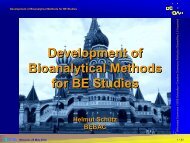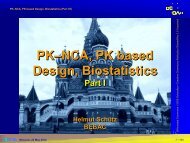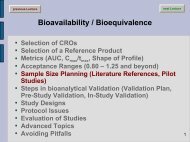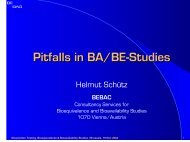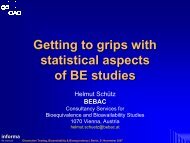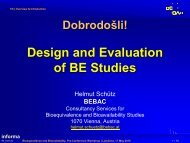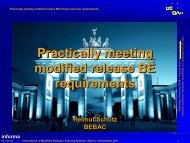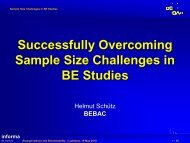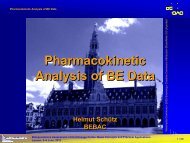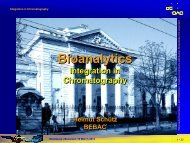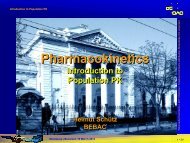informa - BEBAC ⢠Consultancy Services for Bioequivalence
informa - BEBAC ⢠Consultancy Services for Bioequivalence
informa - BEBAC ⢠Consultancy Services for Bioequivalence
You also want an ePaper? Increase the reach of your titles
YUMPU automatically turns print PDFs into web optimized ePapers that Google loves.
5/7 | Statistical Design and Analysis I<br />
Statistical Design<br />
and Analysis I<br />
Helmut Schütz<br />
<strong>BEBAC</strong><br />
<strong>Consultancy</strong> <strong>Services</strong> <strong>for</strong><br />
<strong>Bioequivalence</strong> and Bioavailability Studies<br />
1070 Vienna, Austria<br />
helmut.schuetz@bebac.at<br />
<strong>in<strong>for</strong>ma</strong><br />
life sciences<br />
<strong>Bioequivalence</strong> and Bioavailability, Pre-conference workshop | Budapest, 11 May 2009 1 • 69
5/7 | Statistical Design and Analysis I<br />
Terminology<br />
Bioavailability<br />
relative BA<br />
Comparative BA<br />
absolute BA<br />
<strong>Bioequivalence</strong><br />
Food effect<br />
PK interaction<br />
Pilot study<br />
<strong>in<strong>for</strong>ma</strong><br />
life sciences<br />
<strong>Bioequivalence</strong> and Bioavailability, Pre-conference workshop | Budapest, 11 May 2009 2 • 69
5/7 | Statistical Design and Analysis I<br />
Defining Study Objectives<br />
According to the EU NfG (3. Design and<br />
Conduct of Studies, paragraph 2):<br />
‘A bioequivalence study is basically a<br />
comparative bioavailability study designed<br />
to establish equivalence between test and<br />
reference products.’<br />
Comparative BA,<br />
designed to demonstrate BE,<br />
reference = innovator’s product.<br />
<strong>in<strong>for</strong>ma</strong><br />
life sciences<br />
EMEA Human Medicines Evaluation Unit / CPMP<br />
Note <strong>for</strong> Guidance on the Investigation of Bioavailability and <strong>Bioequivalence</strong> (2001)<br />
http://www.emea.eu.int/pdfs/human/ewp/140198en.pdf#page=6<br />
<strong>Bioequivalence</strong> and Bioavailability, Pre-conference workshop | Budapest, 11 May 2009 3 • 69
5/7 | Statistical Design and Analysis I<br />
Defining Study Objectives<br />
<strong>in<strong>for</strong>ma</strong><br />
life sciences<br />
Comparative BA<br />
true experiment; no bibliographic comp.<br />
Designed to demonstrate BE<br />
variability,<br />
deviation of test from reference,<br />
drop-out rate,…<br />
to be able (statistical power!) to demonstrate BE<br />
Reference = Innovator’s product<br />
#1: BE [90%–125%]<br />
#2: BE [80%–110%]<br />
#3: not BE [76%–103%]; (but ‘BE’ to #2)<br />
<strong>Bioequivalence</strong> and Bioavailability, Pre-conference workshop | Budapest, 11 May 2009 4 • 69
5/7 | Statistical Design and Analysis I<br />
Defining Study Objectives<br />
Definition of BE (EU NfG, Section 2.4)<br />
‘Two medicinal products are bioequivalent if<br />
they are pharmaceutically equivalent or<br />
pharmaceutical alternatives and if their bioavailabilities<br />
after administration in the same<br />
molar dose are similar to such degree that<br />
their effects, with respect to both efficacy and<br />
safety, will be essentially the same.’<br />
<strong>in<strong>for</strong>ma</strong><br />
life sciences<br />
<strong>Bioequivalence</strong> and Bioavailability, Pre-conference workshop | Budapest, 11 May 2009 5 • 69
5/7 | Statistical Design and Analysis I<br />
Defining Study Objectives<br />
In vivo BE mandatory, if<br />
Waiving (NfG Section 5.1.1) not possible<br />
in MA of Generics<br />
Manufacturing changes (EU Major variation type<br />
II(d)-(f) ~ FDA SUPAC Level 3)<br />
Pharmacokinetic interaction studies,<br />
Studies of fixed-combination products.<br />
‘[…] are similar to such degree that their effects,<br />
with respect to both efficacy and safety,<br />
will be essentially the same.’<br />
<strong>in<strong>for</strong>ma</strong><br />
life sciences<br />
<strong>Bioequivalence</strong> and Bioavailability, Pre-conference workshop | Budapest, 11 May 2009 6 • 69
5/7 | Statistical Design and Analysis I<br />
Defining Study Objectives<br />
Statistical concept of BE also applicable to<br />
Food effect studies,<br />
Pharmacokinetic interaction studies,<br />
Studies of fixed-combination products.<br />
‘[…] are similar to such degree that their effects,<br />
with respect to both efficacy and safety, will be<br />
essentially the same.’<br />
EMEA Human Medicines Evaluation Unit / CPMP<br />
Modified Release Oral and Transdermal Dosage Forms: Section II (Quality)<br />
CPMP/EWP/280/96 (1999)<br />
EMEA Human Medicines Evaluation Unit / CPMP<br />
The Investigation of Drug Interactions<br />
CPMP/EWP/560/95 (1997)<br />
EMEA<br />
Fixed Combination Medicinal Products<br />
CPMP/EWP/240/95 Rev. 1 (2008)<br />
<strong>in<strong>for</strong>ma</strong><br />
life sciences<br />
<strong>Bioequivalence</strong> and Bioavailability, Pre-conference workshop | Budapest, 11 May 2009 7 • 69
5/7 | Statistical Design and Analysis I<br />
Defining Study Objectives<br />
Since in vivo BE relies on ‘rich’ PK data:<br />
Sufficient number of blood samples (C max !) / urine<br />
collection periods<br />
Sampling long enough to cover ≥80% of AUC ∞<br />
Wash-out ≥3× t ½ (recommended ≥5× t ½ )<br />
Saturation phase long enough to reach<br />
steady-state: ≥5× t ½ (recomm. ≥7× t ½ )<br />
Pre-dose samples (carry-over,<br />
compliance)<br />
EU Draft NfG (2008): <strong>for</strong> IR<br />
<strong>for</strong>mulations no more<br />
sampling beyond 72 hours!<br />
<strong>in<strong>for</strong>ma</strong><br />
life sciences<br />
<strong>Bioequivalence</strong> and Bioavailability, Pre-conference workshop | Budapest, 11 May 2009 8 • 69
5/7 | Statistical Design and Analysis I<br />
Defining Study Objectives<br />
PK metrics<br />
Extent of bioavailability / Total exposure<br />
single dose<br />
AUC t<br />
, AUC ∞<br />
(plasma)<br />
Ae t<br />
, Ae ∞<br />
(urine)<br />
steady state<br />
AUC τ<br />
, AUC 24h<br />
, (plasma)<br />
Ae τ<br />
, Ae 24h<br />
, (urine)<br />
<strong>in<strong>for</strong>ma</strong><br />
life sciences<br />
<strong>Bioequivalence</strong> and Bioavailability, Pre-conference workshop | Budapest, 11 May 2009 9 • 69
5/7 | Statistical Design and Analysis I<br />
Defining Study Objectives<br />
PK metrics<br />
Rate of bioavailability / Peak exposure / Early<br />
exposure<br />
single dose<br />
C max<br />
, (t max<br />
, partial AUC) (plasma)<br />
∆Ae max<br />
(urine)<br />
steady state<br />
as above<br />
Fluctuation [PTF = (C max<br />
–C min<br />
)/C av<br />
]<br />
MR <strong>for</strong>mulations<br />
<strong>in<strong>for</strong>ma</strong><br />
life sciences<br />
MRT, HVD, t 75%<br />
<strong>Bioequivalence</strong> and Bioavailability, Pre-conference workshop | Budapest, 11 May 2009 10 • 69
5/7 | Statistical Design and Analysis I<br />
Assumptions: General<br />
World ‘Reality’<br />
α<br />
β<br />
Model ‘Data’<br />
H0<br />
HA<br />
Theory ‘Truth’<br />
<strong>in<strong>for</strong>ma</strong><br />
life sciences<br />
<strong>Bioequivalence</strong> and Bioavailability, Pre-conference workshop | Budapest, 11 May 2009
5/7 | Statistical Design and Analysis I<br />
Assumptions: Pharmacokinetics<br />
F ⋅<br />
D<br />
AUC<br />
⋅ CL<br />
1 1<br />
1 1<br />
,<br />
F ⋅<br />
D<br />
AUC<br />
⋅ CL<br />
2 2<br />
2 2<br />
AUC1<br />
Frel ( BA) =<br />
AUC<br />
2<br />
Assumption 1: D 1 =D 2 (D 1 /D 2 =1 * )<br />
Assumption 2: CL 1 =CL 2<br />
<strong>in<strong>for</strong>ma</strong><br />
life sciences<br />
<strong>Bioequivalence</strong> and Bioavailability, Pre-conference workshop | Budapest, 11 May 2009 12 • 69
5/7 | Statistical Design and Analysis I<br />
Assumptions: Statistics<br />
Distribution<br />
IDD (Independent Identically Distribution)<br />
1.4<br />
Test<br />
Reference<br />
1.2<br />
1.0<br />
0.8<br />
0.6<br />
0.4<br />
0.2<br />
<strong>in<strong>for</strong>ma</strong><br />
life sciences<br />
0.0<br />
0.0 0.5 1.0 1.5 2.0 2.5 3.0<br />
<strong>Bioequivalence</strong> and Bioavailability, Pre-conference workshop | Budapest, 11 May 2009 13 • 69
5/7 | Statistical Design and Analysis I<br />
Assumptions: Statistics<br />
Multiplicative Model<br />
Log-Trans<strong>for</strong>mation (PK, Analytics)<br />
1.4<br />
Test<br />
Reference<br />
1.2<br />
1.0<br />
0.8<br />
0.6<br />
0.4<br />
0.2<br />
<strong>in<strong>for</strong>ma</strong><br />
life sciences<br />
0.0<br />
-1.00 -0.75 -0.50 -0.25 0.00 0.25 0.50 0.75 1.00<br />
<strong>Bioequivalence</strong> and Bioavailability, Pre-conference workshop | Budapest, 11 May 2009 14 • 69
5/7 | Statistical Design and Analysis I<br />
Assumptions: Statistics<br />
Multiplicative Model (X-over without carryover)<br />
X ijk = µ · π k · Φ l · s ik · e ijk<br />
X ijk : ln-trans<strong>for</strong>med response of j-th subject<br />
(j=1,…,n i ) in i-th sequence (i=1,2) and k-th<br />
period (k=1,2), µ: global mean, µ l : expected<br />
<strong>for</strong>mulation means (l=1,2: µ l =µ test , µ 2 =µ ref. ),<br />
π k : fixed period effects, Φ l : fixed <strong>for</strong>mulation<br />
effects (l=1,2: Φ l =Φ test , Φ 2 =Φ ref. )<br />
<strong>in<strong>for</strong>ma</strong><br />
life sciences<br />
<strong>Bioequivalence</strong> and Bioavailability, Pre-conference workshop | Budapest, 11 May 2009 15 • 69
5/7 | Statistical Design and Analysis I<br />
Assumptions: Statistics<br />
Multiplicative Model (X-over without carryover)<br />
<strong>in<strong>for</strong>ma</strong><br />
life sciences<br />
X ijk = µ · π k · Φ l · s ik · e ijk<br />
s ik : random subject effect, e ijk : random error<br />
Main Assumptions:<br />
All ln{s ik } and ln{e ijk } are independently and<br />
normally distributed about unity with<br />
variances σ² s and σ² e .<br />
All observations made on different subjects<br />
are independent.<br />
<strong>Bioequivalence</strong> and Bioavailability, Pre-conference workshop | Budapest, 11 May 2009 16 • 69
5/7 | Statistical Design and Analysis I<br />
Global Harmonization<br />
Trans<strong>for</strong>mations (e.g. […], logarithm) should be specified<br />
in the protocol and a rationale provided […]. The<br />
general principles guiding the use of trans<strong>for</strong>mations to<br />
ensure that the assumptions underlying the statistical<br />
methods are met are to be found in standard texts […].<br />
In the choice of statistical methods due attention should<br />
be paid to the statistical distribution […]. When making<br />
this choice (<strong>for</strong> example between parametric and nonparametric<br />
methods) it is important to bear in mind the<br />
need to provide statistical estimates of the size of treatment<br />
effects together with confidence intervals […].<br />
<strong>in<strong>for</strong>ma</strong><br />
life sciences<br />
ICH Topic E 9<br />
Statistical Principles <strong>for</strong> Clinical Trials (1998)<br />
<strong>Bioequivalence</strong> and Bioavailability, Pre-conference workshop | Budapest, 11 May 2009 17 • 69
5/7 | Statistical Design and Analysis I<br />
Global Harmonization<br />
No analysis is complete until the assumptions that have<br />
been made in the modeling have been checked. Among<br />
the assumptions are that the repeated measurements<br />
on each subject are independent, normally distributed<br />
random variables with equal variances. Perhaps the<br />
most important advantage of <strong>for</strong>mally fitting a linear<br />
model is that diagnostic <strong>in<strong>for</strong>ma</strong>tion on the validity of the<br />
assumed model can be obtained. These assumptions<br />
can be most easily checked by analyzing the residuals.<br />
<strong>in<strong>for</strong>ma</strong><br />
life sciences<br />
Jones B and MG Kenward<br />
Design and Analysis of Cross-Over Trials<br />
Chapman & Hall, Boca Raton (2 nd ed 2003)<br />
<strong>Bioequivalence</strong> and Bioavailability, Pre-conference workshop | Budapest, 11 May 2009 18 • 69
5/7 | Statistical Design and Analysis I<br />
Nonparametrics<br />
The limited sample size in a typical BE study precludes<br />
a reliable determination of the distribution of the data<br />
set. Sponsors and/or applicants are not encouraged to<br />
test <strong>for</strong> normality of error distribution after log-trans<strong>for</strong>mation<br />
[…].<br />
FDA, Center <strong>for</strong> Drug Evaluation and Research (CDER)<br />
Guidance <strong>for</strong> Industry: Statistical Approaches to Establishing <strong>Bioequivalence</strong> (2001)<br />
But: acceptable in<br />
Turkey (MOH, November 2005)<br />
Saudia Arabia (SFDA, May 2005)<br />
<strong>in<strong>for</strong>ma</strong><br />
life sciences<br />
<strong>Bioequivalence</strong> and Bioavailability, Pre-conference workshop | Budapest, 11 May 2009 19 • 69
5/7 | Statistical Design and Analysis I<br />
Nonparametrics<br />
5. In which cases may a non-parametric statistical model<br />
be used<br />
The NfG states under 3.6.1–Statistical analysis: “AUC and C max<br />
should be analysed using ANOVA after log trans<strong>for</strong>mation.”<br />
The reasons <strong>for</strong> this request are the following:<br />
a) the AUC and C max<br />
values as biological parameters are usually not<br />
normally distributed;<br />
b) a multiplicative model may be plausible;<br />
c) after log trans<strong>for</strong>mation the distribution may allow a parametric<br />
analysis.<br />
Comments:<br />
a) – true b) – true c) – maybe, but may also terribly fail<br />
EMEA/CHMP/EWP/40326/2006<br />
Questions & Answers on the BA and BE Guideline (2006)<br />
<strong>in<strong>for</strong>ma</strong><br />
life sciences<br />
<strong>Bioequivalence</strong> and Bioavailability, Pre-conference workshop | Budapest, 11 May 2009 20 • 69
5/7 | Statistical Design and Analysis I<br />
Nonparametrics<br />
<strong>in<strong>for</strong>ma</strong><br />
life sciences<br />
5. In which cases may a non-parametric statistical model<br />
be used<br />
However, the true distribution in a pharmacokinetic data set usually<br />
cannot be characterised due to the small sample size, so it is not<br />
recommended to have the analysis strategy depend on a pre-test<br />
<strong>for</strong> normality. Parametric testing using ANOVA on log-trans<strong>for</strong>med<br />
data should be the rule. Results from non-parametric statistical<br />
methods or other statistical approaches are nevertheless welcome<br />
as sensitivity analyses. Such analyses can provide reassurance<br />
that conclusions from the experiment are robust against violations<br />
of the assumptions underlying the analysis strategy.<br />
Comment: It is well known that the efficiency of e.g., the Wilcoxon-Mann-<br />
Whitney test <strong>for</strong> normal distributed data is 3/π ≈ 95.5 %; <strong>for</strong> not<br />
normal distributed data the efficiency is >100 %!<br />
<strong>Bioequivalence</strong> and Bioavailability, Pre-conference workshop | Budapest, 11 May 2009 21 • 69
5/7 | Statistical Design and Analysis I<br />
Nonparametrics<br />
<strong>in<strong>for</strong>ma</strong><br />
life sciences<br />
4.1.8 Evaluation / Statistical analysis<br />
The pharmacokinetic parameters under consideration should be<br />
analysed using ANOVA (or equivalent parametric method). The<br />
data should be trans<strong>for</strong>med prior to analysis using a logarithmic<br />
trans<strong>for</strong>mation. A confidence interval <strong>for</strong> the difference between<br />
<strong>for</strong>mulations on the log-trans<strong>for</strong>med scale is obtained from the<br />
ANOVA model. This confidence interval is then back-trans<strong>for</strong>med<br />
to obtain the desired confidence interval <strong>for</strong> the ratio on the original<br />
scale. A non-parametric analysis is not acceptable.<br />
EMEA/CPMP/EWP/QWP/1401/98 Rev. 1<br />
Draft Guideline on the Investigation of <strong>Bioequivalence</strong> (2008)<br />
‘Also interesting that they now say they will not accept nonparametric<br />
analyses. That seems a step backwards.’<br />
(Walter Hauck, personal communication, Oct 2008)<br />
<strong>Bioequivalence</strong> and Bioavailability, Pre-conference workshop | Budapest, 11 May 2009 22 • 69
5/7 | Statistical Design and Analysis I<br />
Global Harmonization<br />
FDA, , EMEA (Q&A, BE Draft)<br />
ln-Trans<strong>for</strong>mation<br />
(based on on PK, PK, analytics)<br />
Parametric Evaluation<br />
(e.g., ANOVA)<br />
Data Dataand and Residuals<br />
normally distributed <br />
no no<br />
Nonparametric Evaluation<br />
(e.g., WMW)<br />
yes<br />
Parametric Evaluation<br />
(e.g., ANOVA)<br />
ICH<br />
Good Statistical Practice<br />
<strong>in<strong>for</strong>ma</strong><br />
life sciences<br />
<strong>Bioequivalence</strong> and Bioavailability, Pre-conference workshop | Budapest, 11 May 2009 23 • 69
5/7 | Statistical Design and Analysis I<br />
Global Harmonization<br />
<strong>in<strong>for</strong>ma</strong><br />
life sciences<br />
In almost all regulations two metrics are<br />
necessary to demonstrate BE, namely<br />
extent (e.g., AUC t , AUC ∞ , Ae), and<br />
rate (e.g., C max , PTF) of exposure.<br />
One exception: US-FDA (where AUC ∞ and<br />
AUC t must demonstrate extent of BE)<br />
Although stated in the GL, such a<br />
requirement is statistically flawed.<br />
Multiplicity issues (what is the patient’s risk)<br />
Impossible α-adjustment (interdependence)<br />
There can be only one!<br />
<strong>Bioequivalence</strong> and Bioavailability, Pre-conference workshop | Budapest, 11 May 2009 24 • 69
5/7 | Statistical Design and Analysis I<br />
Basic Designs<br />
Single Dose / Multiple Dose<br />
Cross-over<br />
Standard 2×2<br />
Higher Order Designs (<strong>for</strong> more than two treatments)<br />
Latin Squares<br />
Variance Balanced Designs (Williams’ Designs)<br />
Incomplete Block Designs<br />
Replicate designs<br />
Parallel Groups<br />
<strong>in<strong>for</strong>ma</strong><br />
life sciences<br />
<strong>Bioequivalence</strong> and Bioavailability, Pre-conference workshop | Budapest, 11 May 2009 25 • 69
5/7 | Statistical Design and Analysis I<br />
Single Dose / Multiple Dose<br />
<strong>in<strong>for</strong>ma</strong><br />
life sciences<br />
Single Dose recommended in most GLs, but<br />
steady-state studies<br />
may be required:<br />
in the case of dose- or time-dependent pharmacokinetics<br />
<strong>for</strong> some modified release products (additionally to single dose<br />
BE)<br />
may be considered:<br />
if problems of sensitivity preclude sufficiently precise plasma<br />
concentration measurements after SD administration. With<br />
current developments in bioanalytical methodology, you should<br />
have strong evidence of infeasibility if you claim the necessity of<br />
a MD study based on lacking methods.<br />
Regulators are concerned with efficacy/safety issues – not with the<br />
budget of pharmaceutical companies!<br />
<strong>Bioequivalence</strong> and Bioavailability, Pre-conference workshop | Budapest, 11 May 2009 26 • 69
5/7 | Statistical Design and Analysis I<br />
Single Dose / Multiple Dose<br />
<strong>in<strong>for</strong>ma</strong><br />
life sciences<br />
Steady-state studies<br />
No Wash-out between Periods (Switch-Over)!<br />
In order to fulfil the superposition principle of linear<br />
pharmacokinetics (AUC τ = AUC ∞ ), you must<br />
demonstrate achievement of steady-state<br />
Linear regression of pre-dose values in saturation<br />
phase<br />
30 mg paroxetine oad<br />
slope (from at least the last three<br />
values) should not significantly<br />
(p>0.05, two-sided) differ from zero,<br />
subjects not in steady-state at begin<br />
of the profile(s) should be excluded<br />
from the evaluation – if stated in<br />
protocol!<br />
<strong>Bioequivalence</strong> and Bioavailability, Pre-conference workshop | Budapest, 11 May 2009 27 • 69<br />
concentration (ng/ml)<br />
40<br />
30<br />
20<br />
10<br />
0<br />
0 24 48 72 96 120 144 168 192 216 240 264 288 312 336 360 384 408 432 456 480 504 528 552 576 600 624 648 672<br />
time (h)<br />
reference<br />
test<br />
40<br />
30<br />
20<br />
10<br />
0
5/7 | Statistical Design and Analysis I<br />
Single Dose / Multiple Dose<br />
<strong>in<strong>for</strong>ma</strong><br />
life sciences<br />
Steady-state studies<br />
Demonstration of steady-state (cont’d)<br />
Multivariate method (simultaneous testing of all predose<br />
values in all subjects)<br />
E.g., Hotellings T²<br />
Benefit:<br />
additional statement possible when steady-state<br />
was reached<br />
Drawback: if significant result, no possibility to exclude<br />
particular subjects (rendering the entire study<br />
worthless).<br />
t-test of last two pre-dose values<br />
Pro:<br />
Con:<br />
most easy to per<strong>for</strong>m, relatively insensitive<br />
to outliers<br />
as above<br />
<strong>Bioequivalence</strong> and Bioavailability, Pre-conference workshop | Budapest, 11 May 2009 28 • 69
5/7 | Statistical Design and Analysis I<br />
Cross-over over designs<br />
Standard 2×2×2 (two-treatment two-sequence<br />
two-period) design<br />
Each subject is randomly assigned to either<br />
sequence RT or sequence TR at two treatment<br />
periods<br />
Dosing periods are separated by a washout period of<br />
sufficient length <strong>for</strong> the drug received in the first period to<br />
be completely metabolized or excreted from the circulation.<br />
Smaller subject numbers compared to a parallel design,<br />
since the within-subject variability determines sample size<br />
(rather than between-subject variability).<br />
<strong>in<strong>for</strong>ma</strong><br />
life sciences<br />
<strong>Bioequivalence</strong> and Bioavailability, Pre-conference workshop | Budapest, 11 May 2009 29 • 69
5/7 | Statistical Design and Analysis I<br />
Cross-over over designs<br />
Standard 2×2×2 design<br />
Period<br />
I<br />
II<br />
Subjects<br />
RANDOMIZATION<br />
Sequence 1<br />
Sequence 2<br />
Reference<br />
Test<br />
WASHOUT<br />
Test<br />
Reference<br />
<strong>in<strong>for</strong>ma</strong><br />
life sciences<br />
<strong>Bioequivalence</strong> and Bioavailability, Pre-conference workshop | Budapest, 11 May 2009 30 • 69
5/7 | Statistical Design and Analysis I<br />
Assumptions: Cross-over<br />
over<br />
Multiplicative Model (X-over without carryover)<br />
X ijk = µ · π k · Φ l · s ik · e ijk<br />
All ln{s ik } and ln{e ijk } are independently and normally distributed<br />
about unity with variances σ² s and σ² e .<br />
This assumption may not hold true <strong>for</strong> all <strong>for</strong>mulations;<br />
if the reference <strong>for</strong>mulation shows higher variability than the test<br />
<strong>for</strong>mulation, a ‘good’ test will be penalized <strong>for</strong> the ‘bad’ reference.<br />
All observations made on different subjects are independent.<br />
This assumption should not be a problem, unless you plan to<br />
include twins or triplets in your study…<br />
<strong>in<strong>for</strong>ma</strong><br />
life sciences<br />
<strong>Bioequivalence</strong> and Bioavailability, Pre-conference workshop | Budapest, 11 May 2009 31 • 69
5/7 | Statistical Design and Analysis I<br />
Cross-over over designs<br />
Standard 2×2×2 design<br />
Advantages<br />
Globally applied standard protocol <strong>for</strong> BE<br />
Straigth<strong>for</strong>ward statistical analysis<br />
Disadvantages<br />
Not suitable <strong>for</strong> drugs with long half life (→ parallel groups)<br />
Not optimal <strong>for</strong> studies in patients with instable diseases<br />
(→ parallel groups)<br />
Not optimal <strong>for</strong> HVDs (→ Replicate Designs)<br />
<strong>in<strong>for</strong>ma</strong><br />
life sciences<br />
<strong>Bioequivalence</strong> and Bioavailability, Pre-conference workshop | Budapest, 11 May 2009 32 • 69
5/7 | Statistical Design and Analysis I<br />
Cross-over over designs<br />
Higher Order Designs (<strong>for</strong> more than two<br />
treatments)<br />
Latin Squares<br />
Each subject is randomly assigned to sequences,<br />
where number of treatments = number of<br />
sequences = number of periods.<br />
<strong>in<strong>for</strong>ma</strong><br />
life sciences<br />
<strong>Bioequivalence</strong> and Bioavailability, Pre-conference workshop | Budapest, 11 May 2009 33 • 69
5/7 | Statistical Design and Analysis I<br />
Cross-over over designs<br />
3×3×3 Latin Square design<br />
Period<br />
I<br />
II<br />
III<br />
Subjects<br />
RANDOMIZATION<br />
Sequence 1 Ref.<br />
Sequence 2 Test 1<br />
WASHOUT 1<br />
Test 1<br />
Test 2<br />
Sequence 3 Test 2 Ref.<br />
WASHOUT 2<br />
Test 2<br />
Ref.<br />
Test 1<br />
<strong>in<strong>for</strong>ma</strong><br />
life sciences<br />
<strong>Bioequivalence</strong> and Bioavailability, Pre-conference workshop | Budapest, 11 May 2009 34 • 69
5/7 | Statistical Design and Analysis I<br />
Cross-over over designs<br />
<strong>in<strong>for</strong>ma</strong><br />
life sciences<br />
3×3×3 Latin Square design<br />
Advantages<br />
Allows to choose between two candidate test <strong>for</strong>mulations or<br />
comparison of a test <strong>for</strong>mulation with two references<br />
Easy to adapt<br />
Number of subjects in the study is a multiplicative of three<br />
Design <strong>for</strong> establishment of Dose Proportionality<br />
Disadvantages<br />
Statistical analysis more complicated (especially in the case of<br />
drop-outs and a small sample size) – not available in some<br />
pieces of software<br />
Extracted pairwise comparisons are imbalanced<br />
May need measures against multiplicity (increasing the sample<br />
size)<br />
Not mentioned in any guideline<br />
<strong>Bioequivalence</strong> and Bioavailability, Pre-conference workshop | Budapest, 11 May 2009 35 • 69
5/7 | Statistical Design and Analysis I<br />
Cross-over over designs<br />
<strong>in<strong>for</strong>ma</strong><br />
life sciences<br />
Higher Order Designs (<strong>for</strong> more than two<br />
treatments)<br />
Variance Balanced Designs (Williams’ Designs)<br />
For e.g., three <strong>for</strong>mulations there are three possible pairwise<br />
differences among <strong>for</strong>mulation means (i.e., <strong>for</strong>m. 1 vs. <strong>for</strong>m. 2.,<br />
<strong>for</strong>m 2 vs. <strong>for</strong>m. 3, and <strong>for</strong>m. 1 vs. <strong>for</strong>m. 3)<br />
It is desirable to estimate these pairwise effects with the same<br />
degree of precision (there is a common variance <strong>for</strong> each pair)<br />
Each <strong>for</strong>mulation occurs only once with each subject<br />
Each <strong>for</strong>mulation occurs the same number of times in each period<br />
The number of subjects who receive <strong>for</strong>mulation i in some period<br />
followed by <strong>for</strong>mulation j in the next period is the same <strong>for</strong> all i # j<br />
Such a design <strong>for</strong> three <strong>for</strong>mulations is the three-treatment sixsequence<br />
three-period Williams’ Design<br />
<strong>Bioequivalence</strong> and Bioavailability, Pre-conference workshop | Budapest, 11 May 2009 36 • 69
5/7 | Statistical Design and Analysis I<br />
Cross-over over designs<br />
Williams’ Design <strong>for</strong> three treatments<br />
Sequence<br />
I<br />
Period<br />
II<br />
III<br />
1<br />
R<br />
T 2<br />
T 1<br />
2<br />
T 1<br />
R<br />
T 2<br />
3<br />
T 2<br />
T 1<br />
R<br />
4<br />
T 1<br />
T 2<br />
R<br />
5<br />
T 2<br />
R<br />
T 1<br />
6<br />
R<br />
T 1<br />
T 2<br />
<strong>in<strong>for</strong>ma</strong><br />
life sciences<br />
<strong>Bioequivalence</strong> and Bioavailability, Pre-conference workshop | Budapest, 11 May 2009 37 • 69
5/7 | Statistical Design and Analysis I<br />
Cross-over over designs<br />
Williams’ Design <strong>for</strong> four treatments<br />
Sequence<br />
I<br />
Period<br />
II III<br />
IV<br />
1<br />
R<br />
T 3<br />
T 1<br />
T 2<br />
2<br />
3<br />
T 1<br />
T 2<br />
R<br />
T 1<br />
T 2<br />
T 3<br />
T 3<br />
R<br />
4<br />
T 3<br />
T 2<br />
R<br />
T 1<br />
<strong>in<strong>for</strong>ma</strong><br />
life sciences<br />
<strong>Bioequivalence</strong> and Bioavailability, Pre-conference workshop | Budapest, 11 May 2009 38 • 69
5/7 | Statistical Design and Analysis I<br />
Cross-over over designs<br />
<strong>in<strong>for</strong>ma</strong><br />
life sciences<br />
Williams’ Designs<br />
Advantages<br />
Allows to choose between two candidate test <strong>for</strong>mulations or<br />
comparison of a test <strong>for</strong>mulation with two references<br />
Design <strong>for</strong> establishment of Dose Proportionality<br />
Paired comparisons (e.g., <strong>for</strong> a nonparametric method) can be<br />
extracted, which are also balanced<br />
Mentioned in Brazil’s (ANVISA) guideline<br />
Disadvantages<br />
Mores sequences <strong>for</strong> an odd number of treatment needed than in<br />
a Latin Squares design (but equal <strong>for</strong> even number)<br />
Statistical analysis more complicated (especially in the case of<br />
drop-outs) – not available in some softwares<br />
May need measures against multiplicity (increasing the sample<br />
size)<br />
<strong>Bioequivalence</strong> and Bioavailability, Pre-conference workshop | Budapest, 11 May 2009 39 • 69
5/7 | Statistical Design and Analysis I<br />
Cross-over over designs<br />
Extraction of 2×2 comparisons (T 1 /R, T 2 /R)<br />
Latin Squares<br />
Seq.<br />
1<br />
2<br />
P 1<br />
T 1<br />
T 2<br />
3 R<br />
P 2<br />
T 2<br />
R<br />
P 3<br />
T 1<br />
T 1<br />
T 2<br />
R 1<br />
Seq. P 1<br />
’<br />
T 1<br />
2 R<br />
3 R<br />
P 2<br />
’<br />
R<br />
T 1<br />
T 1<br />
Seq.<br />
1<br />
2<br />
P 1<br />
”<br />
T 2<br />
T 2<br />
3 R<br />
P 2<br />
”<br />
R<br />
R<br />
T 2<br />
imbalanced<br />
<strong>in<strong>for</strong>ma</strong><br />
life sciences<br />
Williams’ design<br />
Seq.<br />
1<br />
2<br />
3 R<br />
4<br />
5<br />
6<br />
P 1<br />
T 1<br />
T 2<br />
T 1<br />
T 2<br />
R<br />
P 2<br />
T 2<br />
R<br />
T 1<br />
T 2<br />
R<br />
T 1<br />
T 2<br />
P 3<br />
R 1<br />
T 1<br />
T 2<br />
R 5<br />
T 1<br />
Seq. P 1<br />
’<br />
2 R<br />
3 R<br />
4<br />
<strong>Bioequivalence</strong> and Bioavailability, Pre-conference workshop | Budapest, 11 May 2009 40 • 69<br />
T 1<br />
T 1<br />
T 1<br />
6 R<br />
P 2<br />
’<br />
R<br />
T 1<br />
T 1<br />
R<br />
R<br />
T 1<br />
Seq.<br />
1<br />
2<br />
3 R<br />
4 R<br />
5<br />
6<br />
P 1<br />
”<br />
T 2<br />
T 2<br />
T 2<br />
R<br />
balanced<br />
P 2<br />
”<br />
R<br />
R<br />
T 2<br />
T 2<br />
R<br />
T 2
5/7 | Statistical Design and Analysis I<br />
Cross-over over designs<br />
Higher Order Designs (cont’d)<br />
Bonferroni-correction needed (sample size!)<br />
If more than one <strong>for</strong>mulation will be marketed (<strong>for</strong> three<br />
simultaneous comparisons without correction patients’ risk<br />
increases from 5 % to 14 %).<br />
Sometimes requested by regulators in dose proportionality.<br />
<strong>in<strong>for</strong>ma</strong><br />
life sciences<br />
k<br />
P α=0.05<br />
P α=0.10<br />
α adj.<br />
P αadj.<br />
α adj.<br />
P αadj.<br />
1 5.00% 10.00% 0.0500 5.00% 0.100 10.00%<br />
2 9.75% 19.00% 0.0250 4.94% 0.050 9.75%<br />
3 14.26% 27.10% 0.0167 4.92% 0.033 6.67%<br />
4 18.55% 34.39% 0.0125 4.91% 0.025 9.63%<br />
5 22.62% 40.95% 0.0100 4.90% 0.020 9.61%<br />
6 26.49% 46.86% 0.0083 4.90% 0.017 9.59%<br />
<strong>Bioequivalence</strong> and Bioavailability, Pre-conference workshop | Budapest, 11 May 2009 41 • 69
5/7 | Statistical Design and Analysis I<br />
Cross-over over designs<br />
<strong>in<strong>for</strong>ma</strong><br />
life sciences<br />
Replicate designs<br />
Each subject is randomly assigned to sequences,<br />
where at least one of the treatments is administered<br />
at least twice.<br />
Not only the global within-subject variability, but also the<br />
within-subject variability per treatment may be estimated.<br />
Smaller subject numbers compared to a standard 2×2×2<br />
design – but outweighed by an increased number of<br />
periods.<br />
Same overall number of individual treatments!<br />
Mandatory in the EU if an extended acceptance range <strong>for</strong><br />
C max (0.75–1.33) is aimed at (HVDP must be demonstrated<br />
in advance)<br />
<strong>Bioequivalence</strong> and Bioavailability, Pre-conference workshop | Budapest, 11 May 2009 42 • 69
5/7 | Statistical Design and Analysis I<br />
Cross-over over designs<br />
<strong>in<strong>for</strong>ma</strong><br />
life sciences<br />
Replicate designs<br />
Advantages<br />
Some experience from FDA’s initiative on population BE (PBE)<br />
and individual BE (IBE)<br />
Reference scaling average bioequivalence (RSABE)<br />
Handling of outliers (subject-by-<strong>for</strong>mulation interaction may be<br />
ruled out)<br />
Disadvantages<br />
Statistical analysis complicated (especially in the case of dropouts<br />
and if RSABE is the target) – not available in standard<br />
software<br />
Many publications, but still no agreement on methodology<br />
Mentioned only in South African GL; will be adopted by FDA<br />
<strong>Bioequivalence</strong> and Bioavailability, Pre-conference workshop | Budapest, 11 May 2009 43 • 69
5/7 | Statistical Design and Analysis I<br />
Cross-over over designs<br />
<strong>in<strong>for</strong>ma</strong><br />
life sciences<br />
Replicate designs<br />
Examples<br />
Two-sequence three-period<br />
T R T<br />
R T R<br />
Sample size to obtain the same power as a 2×2×2 study: 75%<br />
Two-sequence four-period<br />
T R T R<br />
R T R T<br />
Sample size to obtain the same power as a 2×2×2 study: 50%<br />
and many others… (FDA <strong>for</strong> RSABE: TRR–RTR–RRT)<br />
The statistical model is a little bit complicated – and dependent<br />
on the actual design<br />
X ijkl = µ · π k · Φ l · s ij · e ijkl<br />
<strong>Bioequivalence</strong> and Bioavailability, Pre-conference workshop | Budapest, 11 May 2009 44 • 69
5/7 | Statistical Design and Analysis I<br />
HVDs/HVDPs<br />
HVDPs<br />
Highly Variable Drugs / Drug Products<br />
(intra-subject variability >30 %)<br />
USA Replicate Design recommended.<br />
Reference Scaled Average <strong>Bioequivalence</strong> under<br />
discussion: minimum number of subjects (24 or 36),<br />
restriction on GMR (0.8–1.25)<br />
± EU […] under certain circumstances […] alternative wellestablished<br />
designs could be considered such as […]<br />
replicate designs <strong>for</strong> substances with highly variable<br />
disposition.<br />
Widening of acceptance range in a pivotal BE study (<strong>for</strong><br />
C max only) after demonstration of reference HVDP (pilot<br />
replicate design).<br />
RSABE according to the Draft GL not acceptable!<br />
<strong>in<strong>for</strong>ma</strong><br />
life sciences<br />
<strong>Bioequivalence</strong> and Bioavailability, Pre-conference workshop | Budapest, 11 May 2009 45 • 69
5/7 | Statistical Design and Analysis I<br />
HVDs/HVDPs<br />
HVDPs<br />
Does knowledge of the PK profile always<br />
help in demonstrating bioequivalence<br />
when a conventional BE study is unsuitable<br />
Omeprazole: Highly Variable Drug Product (HVDP),<br />
higher variability in fed state as compared to fasted<br />
state commonly observed, sensitive to low pH,<br />
breakdown of gastric resistant coating (especially of<br />
the reference product) not unusual, high variability<br />
in C max /t max due to variability in gastric emptying, …<br />
<strong>in<strong>for</strong>ma</strong><br />
life sciences<br />
<strong>Bioequivalence</strong> and Bioavailability, Pre-conference workshop | Budapest, 11 May 2009 46 • 69
5/7 | Statistical Design and Analysis I<br />
HVDs/HVDPs<br />
HVDPs<br />
<strong>in<strong>for</strong>ma</strong><br />
life sciences<br />
Attempt to deal with high variability in C max<br />
Powered to 90%<br />
according to CV<br />
from previous<br />
studies; 140 (!)<br />
subjects and to<br />
80% <strong>for</strong> expected<br />
dropout rate.<br />
Sampling every<br />
30 min up to<br />
14 hours<br />
(7785 total).<br />
t max 15 h<br />
C max 3.5×LLOQ<br />
2000<br />
1000<br />
100<br />
10<br />
5<br />
0 4 8 12 16 20 24<br />
time (hr)<br />
First time t max<br />
t ½ 0.76 h<br />
t ½ 3.15 h<br />
t ½ 12 h<br />
<strong>Bioequivalence</strong> and Bioavailability, Pre-conference workshop | Budapest, 11 May 2009 47 • 69
5/7 | Statistical Design and Analysis I<br />
HVDs/HVDPs<br />
HVDPs<br />
<strong>in<strong>for</strong>ma</strong><br />
life sciences<br />
Ways out<br />
Replicate designs could be considered<br />
e.g. <strong>for</strong> substances with highly variable<br />
pharmacokinetic characteristics.<br />
(EU BE Draft, Section 4.1.2)<br />
Nonparametric methods<br />
A non-parametric analysis is not acceptable.<br />
(BE Draft, Section 4.1.8)<br />
Compartmental (Population PK) methods<br />
The use of compartmental methods <strong>for</strong> the<br />
estimation of parameters is not acceptable.<br />
(BE Draft, Section 4.1.5)<br />
<strong>Bioequivalence</strong> and Bioavailability, Pre-conference workshop | Budapest, 11 May 2009 48 • 69
5/7 | Statistical Design and Analysis I<br />
HVDPs<br />
All (!) ANDAs submitted to FDA/OGD<br />
2003–2005 (1010 studies, 180 drugs)<br />
31% (57/180) highly variable (CV ≥30%)<br />
of these HVDs/HVDPs,<br />
60% due to PK (e.g., first pass metabol.)<br />
20% <strong>for</strong>mulation per<strong>for</strong>mance<br />
20% unclear<br />
Davit BM, Conner DP, Fabian-Fritsch B, Haidar SH, Jiang X, Patel DT, Seo PR,<br />
Suh K, Thompson CL, and LX Yu<br />
Highly variable drugs: observations from bioequivalence data submitted to the FDA <strong>for</strong><br />
new generic drug applications<br />
AAPS J 10(1): 148-56 (2008)<br />
<strong>in<strong>for</strong>ma</strong><br />
life sciences<br />
<strong>Bioequivalence</strong> and Bioavailability, Pre-conference workshop | Budapest, 11 May 2009 49 • 69
5/7 | Statistical Design and Analysis I<br />
HVDPs<br />
<strong>in<strong>for</strong>ma</strong><br />
life sciences<br />
Power to show BE<br />
with 40 subjects <strong>for</strong><br />
CV intra = 30–50%<br />
µT/µR 0.95, CV intra 30%<br />
→ power 0.816<br />
µT/µR 1.00, CV intra 45%<br />
→ power 0.476 <<br />
Roulette 0.486 (!)<br />
µT/µR 0.95, CV intra 45%<br />
→ n=82 (power 0.807)<br />
Power<br />
1<br />
0.9<br />
0.8<br />
0.7<br />
0.6<br />
0.5<br />
0.4<br />
0.3<br />
0.2<br />
0.1<br />
0<br />
2×2 Cross-over<br />
30 % CV<br />
35 % CV<br />
40 % CV<br />
45 % CV<br />
50 % CV<br />
n=40<br />
0.8 0.85 0.9 0.95 1 1.05 1.1 1.15 1.2 1.25<br />
µT/µR<br />
<strong>Bioequivalence</strong> and Bioavailability, Pre-conference workshop | Budapest, 11 May 2009 50 • 69
5/7 | Statistical Design and Analysis I<br />
HVDPs (US/EU)<br />
Advisory Committee <strong>for</strong> Pharmaceutical<br />
Sciences (ACPS) to FDA (10/2006) on HVDs<br />
Follow-up paper in 2008 (likely to be implemented<br />
in next Guideline)<br />
Replicate study design [TRR–RTR–RRT]<br />
Reference Scaled Average <strong>Bioequivalence</strong> (RSABE)<br />
Minimum sample size 24 subjects<br />
Point estimate restricted to [0.80,1.25]<br />
<strong>in<strong>for</strong>ma</strong><br />
life sciences<br />
Haidar SH, Davit B, Chen M-L, Conner D, Lee LM, Li QH, Lionberger R, Makhlouf F, Patel D,<br />
Schuirmann DJ, and LX Yu<br />
<strong>Bioequivalence</strong> Approaches <strong>for</strong> Highly Variable Drugs and Drug Products<br />
Pharmaceutical Research 25/1, 237-241 (2008)<br />
http://www.springerlink.com/content/u503p62056413677/fulltext.pdf<br />
<strong>Bioequivalence</strong> and Bioavailability, Pre-conference workshop | Budapest, 11 May 2009 51 • 69
5/7 | Statistical Design and Analysis I<br />
HVDPs (US/EU)<br />
Reference<br />
Scaled ABE<br />
RSABE vs.<br />
convential ABE<br />
Acceptance Limits<br />
1.8<br />
1.6<br />
1.4<br />
1.2<br />
1<br />
0.8<br />
0.6<br />
<br />
<br />
Sample Size<br />
210<br />
180<br />
150<br />
120<br />
90<br />
60<br />
30<br />
2×2 X-over ABE<br />
<br />
RSABE<br />
<br />
0<br />
<strong>in<strong>for</strong>ma</strong><br />
life sciences<br />
30 40 50 60 70 80<br />
30 40 50 60 70 80<br />
CVintra %<br />
CVintra %<br />
<strong>Bioequivalence</strong> and Bioavailability, Pre-conference workshop | Budapest, 11 May 2009 52 • 69
5/7 | Statistical Design and Analysis I<br />
HVDs/HVDPs<br />
HVDPs<br />
Is suggested EU-method of any good<br />
Replicate designs … (BE Draft, Section 4.1.2)<br />
without scaling<br />
reduce the number of subjects (to 75% <strong>for</strong> a<br />
3-period design and to 50% <strong>for</strong> a 4-period design as<br />
compared to a conventional 2×2),<br />
but keep the theoretical number of treatments<br />
constant:<br />
The potentional drop-out rate increases.<br />
Practically more treatments must be administered in<br />
order to maintain the desired power!<br />
<strong>in<strong>for</strong>ma</strong><br />
life sciences<br />
<strong>Bioequivalence</strong> and Bioavailability, Pre-conference workshop | Budapest, 11 May 2009 53 • 69
5/7 | Statistical Design and Analysis I<br />
Example<br />
HVDs/HVDPs<br />
HVDPs<br />
AR [0.80,1.25], CV intra 49.5%, T/R 0.95%,<br />
power 80%, n 2×2 96<br />
expected dropout rate of 10% per washout<br />
2×2 study: 96+10=106 subjects, 212 treatments<br />
4×2 study: 48+16=64 subjects, 256 treatments<br />
Ethical<br />
Proposed FDA Scaling-Method:<br />
AR [0.7006,1.4273], PE [0.80,1.25], n 34 (!)<br />
<strong>in<strong>for</strong>ma</strong><br />
life sciences<br />
<strong>Bioequivalence</strong> and Bioavailability, Pre-conference workshop | Budapest, 11 May 2009 54 • 69
5/7 | Statistical Design and Analysis I<br />
HVDPs: C ss<br />
ss,min<br />
EMEA Draft BE Guideline (2008)<br />
Acceptance limits<br />
[...] at steady state AUCτ, C max,ss<br />
, and C min,ss<br />
should<br />
be analysed using the same acceptance interval as<br />
stated above.<br />
C min,ss was added probably after concerns <strong>for</strong> oxycodone,<br />
but this metric will be rather tough to meet <strong>for</strong><br />
some drugs.<br />
Since scaling is not allowed, sample sizes are<br />
expected to be very high (variability of<br />
C ss,min » C ss,max ).<br />
<strong>in<strong>for</strong>ma</strong><br />
life sciences<br />
<strong>Bioequivalence</strong> and Bioavailability, Pre-conference workshop | Budapest, 11 May 2009 55 • 69
5/7 | Statistical Design and Analysis I<br />
Early Exposure<br />
Partial AUCs <strong>for</strong> Rapid Onset Drugs<br />
US-FDA 2003 (III.A.8.a.)<br />
[…] that the partial area be truncated at the population<br />
median of T max<br />
values <strong>for</strong> the reference <strong>for</strong>mulation.<br />
We also recommend that at least two quantifiable<br />
samples be collected be<strong>for</strong>e the expected peak<br />
time to allow adequate estimation of the partial area.<br />
Canada-TGD 2005<br />
[…] AUC Reftmax<br />
<strong>for</strong> a test product is defined as the<br />
area under the curve to the time of the maximum<br />
concentration of the reference product, calculated <strong>for</strong><br />
each study subject.<br />
<strong>in<strong>for</strong>ma</strong><br />
life sciences<br />
<strong>Bioequivalence</strong> and Bioavailability, Pre-conference workshop | Budapest, 11 May 2009 56 • 69
5/7 | Statistical Design and Analysis I<br />
Early Exposure<br />
Partial AUCs <strong>for</strong> Rapid Onset Drugs (cont’d)<br />
EU-EMEA BE Draft 2008<br />
When partial AUC is to be determined, frequent early<br />
sampling is recommended with preferably at least<br />
two quantifiable samples be<strong>for</strong>e expected t max<br />
. […]<br />
partial AUCs can be used as a measure of early<br />
exposure. The partial area can in most cases be<br />
truncated at the population median of t max<br />
values <strong>for</strong><br />
the reference <strong>for</strong>mulation. However, an alternative<br />
time point <strong>for</strong> truncating the partial AUC can be used<br />
when clinically relevant. The time point <strong>for</strong> truncating<br />
the partial AUC should be pre-specified and justified<br />
in the study protocol.<br />
<strong>in<strong>for</strong>ma</strong><br />
life sciences<br />
<strong>Bioequivalence</strong> and Bioavailability, Pre-conference workshop | Budapest, 11 May 2009 57 • 69
5/7 | Statistical Design and Analysis I<br />
Early Exposure (HVDP)<br />
Partial AUCs <strong>for</strong> Rapid Onset Drugs (cont’d)<br />
Example<br />
median<br />
t maxref<br />
PE<br />
nonparametric CI<br />
BE<br />
FDA<br />
parametric CI<br />
BE<br />
TGD<br />
BE<br />
1<br />
1.5 h<br />
±0.00 h<br />
-0.25 h<br />
(85%)<br />
+0.25 h<br />
(115%)<br />
yes<br />
90.1%<br />
75.0%<br />
110.1%<br />
no<br />
(CV 26.4%)<br />
85.7%<br />
yes<br />
2<br />
1.5 h<br />
+0.26 h<br />
±0.00 h<br />
(100%)<br />
+0.50 h<br />
(130%)<br />
no<br />
66.1%<br />
53.1%<br />
82.0%<br />
no<br />
(CV 29.7%)<br />
62.4%<br />
no<br />
<strong>in<strong>for</strong>ma</strong><br />
life sciences<br />
Even <strong>for</strong> <strong>for</strong>mulations with low intra-subject variability…<br />
Example 1: AUC t<br />
13.3% C max<br />
17.0%<br />
Example 2: AUC t<br />
6.33% C max<br />
9.43%<br />
…it is unlikely to be able to demonstrate BE due to high<br />
vari-ability of this metric. It is unclear how median t maxref<br />
can be stated in the protocol (EMEA) – the innovator’s<br />
SmPC (=label) mostly states only the arithmetic mean.<br />
<strong>Bioequivalence</strong> and Bioavailability, Pre-conference workshop | Budapest, 11 May 2009 58 • 69
5/7 | Statistical Design and Analysis I<br />
Low Variability<br />
Drugs / Drug Products with CV intra
5/7 | Statistical Design and Analysis I<br />
Parallel Groups<br />
Two-group parallel design<br />
Each subject receives one – and only one –<br />
treatment in a random fashion<br />
Usually each group contains the same number of subjects.<br />
Higher subject numbers compared to a cross-over design,<br />
since the between-subject variability determines sample<br />
size (rather than within-subject variability)<br />
<strong>in<strong>for</strong>ma</strong><br />
life sciences<br />
<strong>Bioequivalence</strong> and Bioavailability, Pre-conference workshop | Budapest, 11 May 2009 60 • 69
5/7 | Statistical Design and Analysis I<br />
Parallel Groups<br />
Two-group parallel design<br />
Subjects<br />
RANDOMIZATION<br />
Group 1<br />
Group 2<br />
Reference<br />
Test<br />
<strong>in<strong>for</strong>ma</strong><br />
life sciences<br />
<strong>Bioequivalence</strong> and Bioavailability, Pre-conference workshop | Budapest, 11 May 2009 61 • 69
5/7 | Statistical Design and Analysis I<br />
Parallel Groups<br />
<strong>in<strong>for</strong>ma</strong><br />
life sciences<br />
Two-group parallel design<br />
Advantages<br />
Clinical part – sometimes – faster than X-over<br />
Straigth<strong>for</strong>ward statistical analysis<br />
Drugs with long half life<br />
Potentially toxic drugs or effect and/or AEs unacceptable in<br />
healthy subjects<br />
Studies in patients, where the condition of the disease irreversibly<br />
changes<br />
Disadvantages<br />
Lower statistical power than X-over (rule of thumb: sample size<br />
should at least be doubled)<br />
Phenotyping mandatory <strong>for</strong> drugs showing polymorphism<br />
<strong>Bioequivalence</strong> and Bioavailability, Pre-conference workshop | Budapest, 11 May 2009 62 • 69
5/7 | Statistical Design and Analysis I<br />
Parallel Groups<br />
<strong>in<strong>for</strong>ma</strong><br />
life sciences<br />
Design Issues<br />
EMEA NfG on BA/BE (2001)<br />
3.2.4 Genetic phenotyping<br />
‘Phenotyping and/or genotyping of subjects should be<br />
considered <strong>for</strong> […] all studies using parallel group design.<br />
If a drug is known to be subject to major genetic<br />
polymorphism, studies could be per<strong>for</strong>med in panels of<br />
subjects of known phenotype or genotype <strong>for</strong> the<br />
polymorphism in question.’<br />
Since the comparison is based on inter-subject effects<br />
One study of the major phenotype/genotype<br />
Two studies of the respective phenotype/genotype – only if<br />
requested!<br />
<strong>Bioequivalence</strong> and Bioavailability, Pre-conference workshop | Budapest, 11 May 2009 63 • 69
5/7 | Statistical Design and Analysis I<br />
Parallel Groups<br />
<strong>in<strong>for</strong>ma</strong><br />
life sciences<br />
Evaluation<br />
FDA/CDER, Statistical Approaches to Establishing<br />
<strong>Bioequivalence</strong> (2001)<br />
Section VI. B.1.d. Parallel Designs<br />
‘For parallel designs, the confidence interval <strong>for</strong> the difference of<br />
means in the log scale can be computed using the total betweensubject<br />
variance. As in the analysis <strong>for</strong> replicated designs<br />
(section VI. B.1.b), equal variances should not be assumed.’<br />
The conventional t-test depends on the assumption that<br />
samples come from populations that have identical variances<br />
‘Naïve pooling’ of variances is relatively robust against unequal<br />
variances, but rather sensitive to inbalanced data<br />
If assumptions are violated, the conventional t-test becomes<br />
liberal (i.e., the CI is too tight; patient’s risk >5%).<br />
<strong>Bioequivalence</strong> and Bioavailability, Pre-conference workshop | Budapest, 11 May 2009 64 • 69
5/7 | Statistical Design and Analysis I<br />
Sample Data Set<br />
<strong>in<strong>for</strong>ma</strong><br />
life sciences<br />
2×2×2 Cross-over Study<br />
24 subjects (balanced:<br />
TR=RT=12)<br />
Single dose<br />
Target parameter: AUC 0-t<br />
CV intra<br />
20.0%<br />
CV inter<br />
32.6%<br />
http://bebac.at/downloads/24sub.txt<br />
(CSV-<strong>for</strong>mat)<br />
<strong>Bioequivalence</strong> and Bioavailability, Pre-conference workshop | Budapest, 11 May 2009 65 • 69<br />
Trt<br />
1<br />
1<br />
1<br />
2<br />
2<br />
2<br />
1<br />
1<br />
1<br />
2<br />
2<br />
2<br />
1<br />
1<br />
1<br />
2<br />
2<br />
2<br />
1<br />
1<br />
1<br />
2<br />
2<br />
2<br />
Rand<br />
RT<br />
RT<br />
RT<br />
TR<br />
TR<br />
TR<br />
RT<br />
RT<br />
RT<br />
TR<br />
TR<br />
TR<br />
RT<br />
RT<br />
RT<br />
TR<br />
TR<br />
TR<br />
RT<br />
RT<br />
RT<br />
TR<br />
TR<br />
TR<br />
Sub<br />
1<br />
2<br />
3<br />
4<br />
5<br />
6<br />
7<br />
8<br />
9<br />
10<br />
11<br />
12<br />
13<br />
14<br />
15<br />
16<br />
17<br />
18<br />
19<br />
20<br />
21<br />
22<br />
23<br />
24<br />
P 1<br />
44.1<br />
33.6<br />
45.5<br />
19.5<br />
67.2<br />
25.7<br />
35.3<br />
26.0<br />
38.2<br />
33.6<br />
25.1<br />
44.1<br />
25.6<br />
58.0<br />
47.2<br />
16.5<br />
47.3<br />
22.6<br />
17.5<br />
51.7<br />
24.5<br />
36.3<br />
29.4<br />
18.3<br />
P 2<br />
39.1<br />
23.8<br />
40.8<br />
21.1<br />
51.5<br />
30.1<br />
26.7<br />
36.5<br />
57.8<br />
32.5<br />
36.8<br />
42.9<br />
20.1<br />
45.3<br />
51.8<br />
21.4<br />
39.4<br />
17.3<br />
30.1<br />
36.0<br />
18.2<br />
27.2<br />
39.6<br />
20.7
5/7 | Statistical Design and Analysis I<br />
Parallel Groups: Example<br />
Evaluation (sample data set, period 1 only)<br />
Original data set<br />
Balanced (T 12, R 12)<br />
Equal variances (s² R 0.1292, s² T 0.1796)<br />
F-ratio test p 0.5947<br />
Levene test p 0.5867<br />
Modified data set<br />
Values of subjects 4 – 6 multiplied by three<br />
Subjects 22 – 24 removed<br />
Inbalanced (T 9, R 12)<br />
Unequal variances (s² R 0.1292, s² T 0.5639)<br />
F-ratio test p 0.0272<br />
Levene test p 0.1070<br />
<strong>in<strong>for</strong>ma</strong><br />
life sciences<br />
<strong>Bioequivalence</strong> and Bioavailability, Pre-conference workshop | Budapest, 11 May 2009 66 • 69
5/7 | Statistical Design and Analysis I<br />
Parallel Groups: Example<br />
Evaluation (original data set)<br />
Is your software able to give a correct answer<br />
Software / Method<br />
‘manual’ (Excel 2000)<br />
R 2.8.1 (2008)<br />
NCSS 2001 (2001)<br />
STATISTICA 5.1H (1997)<br />
WinNonlin 5.2.1 (2008)<br />
Kinetica 5.0.1 (2009)<br />
equal variances<br />
63.51% – 110.19%<br />
63.51% – 110.19%<br />
63.51% – 110.19%<br />
63.51% – 110.19%<br />
63.51% – 110.20%<br />
63.51% – 110.19%<br />
unequal variances<br />
63.48% – 110.25%<br />
63.49% – 110.22%<br />
63.49% – 110.22%<br />
63.49% – 110.22%<br />
not implemented!<br />
not implemented!<br />
<strong>in<strong>for</strong>ma</strong><br />
life sciences<br />
EquivTest/PK (2006) 63.51% – 110.18% not implemented!<br />
<strong>Bioequivalence</strong> and Bioavailability, Pre-conference workshop | Budapest, 11 May 2009 67 • 69
5/7 | Statistical Design and Analysis I<br />
Parallel Groups: Example<br />
Evaluation (modified data set)<br />
Software equal variances<br />
R 2.8.1 (2008) 81.21% – 190.41%<br />
NCSS 2001 (2001) 81.21% – 190.41%<br />
unequal variances<br />
76.36% – 202.51%<br />
76.36% – 202.51%<br />
Inflated α-risk in ‘conventional’ t-test (naïve pooling) is reflected<br />
in a tighter confidence interval.<br />
Preliminary testing <strong>for</strong> equality in variances is flawed* ) and should<br />
be avoided (FDA).<br />
Approximations (e.g., Satterthwaite, Aspin-Welch, Howe, Milliken-<br />
Johnson) are currently not implemented in packages ‘specialized’ in<br />
bioequivalence testing (WinNonlin, Kinetica, EquivTest/PK)!<br />
*) Moser BK and GR Stevens<br />
Homogeneity of variance in the two-sample means test<br />
Amer Statist 46:19-21 (1992)<br />
<strong>in<strong>for</strong>ma</strong><br />
life sciences<br />
<strong>Bioequivalence</strong> and Bioavailability, Pre-conference workshop | Budapest, 11 May 2009 68 • 69
5/7 | Statistical Design and Analysis I<br />
Thank You!<br />
Statistical Design<br />
and Analysis I<br />
Open Questions<br />
(References in handouts of part II)<br />
Helmut Schütz<br />
<strong>BEBAC</strong><br />
<strong>Consultancy</strong> <strong>Services</strong> <strong>for</strong><br />
<strong>Bioequivalence</strong> and Bioavailability Studies<br />
1070 Vienna, Austria<br />
helmut.schuetz@bebac.at<br />
<strong>in<strong>for</strong>ma</strong><br />
life sciences<br />
<strong>Bioequivalence</strong> and Bioavailability, Pre-conference workshop | Budapest, 11 May 2009 69 • 69




